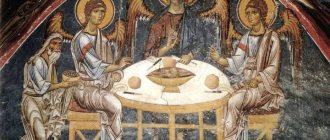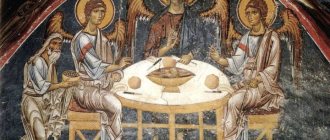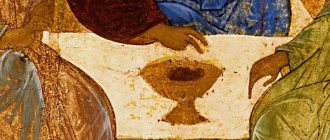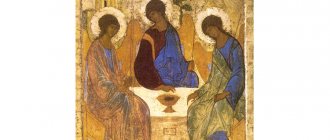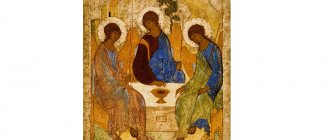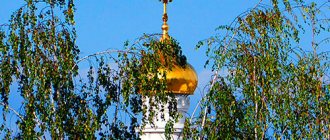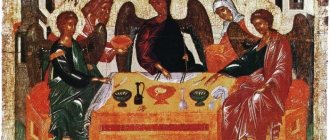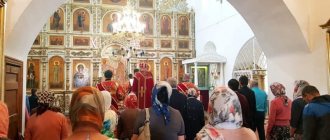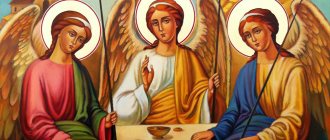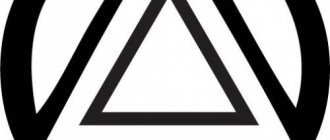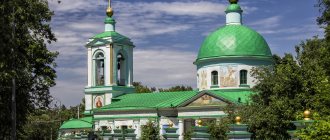Author: Tatyana Soboleva
Date of publication: 05/31/2018
“Here is the limit of what cherubs cover with their wings.” So St. Athanasius the Great speaks of the incomprehensible mystery of the Trinity Divinity. However, our Lord lifts the curtain for the sake of salvation. According to the teachings of St. fathers, God the Trinity, in addition to his relationship to the world, has an infinite fullness of inner life, He is boundless and all-perfect Love.
The Holy Trinity. Painting of the Chapel of Our Lady in Mon. ap. John the Theologian. Patmos, Greece. End of the 12th century
Description
The icon is a board in a vertical format. It depicts three angels sitting at a table on which stands a bowl with the head of a calf. The background features a house (the chambers of Abraham), a tree (the oak of Mamre) and a mountain (Mount Moriah). The figures of angels are arranged so that the lines of their figures form a kind of closed circle. The compositional center of the icon is the bowl. The hands of the middle and left angels bless the cup. There is no active action or movement in the icon - the figures are full of motionless contemplation, and their gaze is directed to eternity. On the background, on the margins, halos and around the bowl there are repaired traces of the nails of the frame.
Iconography
The icon is based on the Old Testament story “The Hospitality of Abraham”, set out in the eighteenth chapter of the biblical book of Genesis. It tells how the forefather Abraham, the ancestor of the chosen people, met three mysterious wanderers near the oak grove of Mamre (in the next chapter they were called angels). During a meal in Abraham's house, he was given a promise about the coming miraculous birth of his son Isaac. According to the will of God, from Abraham a “great and strong nation” was to come, in which “all the nations of the earth will be blessed.” Then two angels went to destroy Sodom, a city that had angered God with the numerous atrocities of its inhabitants, and one stayed with Abraham and talked with him.
In different eras, this plot received different interpretations, but by the 9th-10th centuries the prevailing point of view was that the appearance of three angels to Abraham symbolically revealed the image of the consubstantial and trinitarian God - the Holy Trinity.
It was the Rublev icon, as scientists currently believe, that best corresponded to these ideas. In an effort to reveal the dogmatic doctrine of the Holy Trinity, Rublev abandons the traditional narrative details that were usually included in depictions of the Hospitality of Abraham. There is no Abraham, Sarah, there is no scene of the slaughter of the calf, the attributes of the meal are reduced to a minimum: the angels are presented not eating, but talking. “The angels’ gestures, smooth and restrained, testify to the sublime nature of their conversation.” In the icon, all attention is focused on the silent communication of the three angels.
“The form that most clearly expresses the idea of the consubstantiality of the three hypostases of the Holy Trinity in Rublev’s icon is the circle - it is this that is used as the basis of the composition. Moreover, the angels are not inscribed in a circle - they themselves form it, so that our gaze cannot dwell on any of the three figures and remains, rather, within the space that they limit themselves. The semantic center of the composition is a bowl with the head of a calf - a prototype of the sacrifice of the cross and a reminder of the Eucharist (a silhouette reminiscent of a bowl is also formed by the figures of the left and right angels). A silent dialogue of gestures unfolds around the bowl standing on the table.”
The left angel, symbolizing God the Father, blesses the cup - however, his hand is at a distance, as if he is passing the cup to the central angel, who also blesses it and accepts it, expressing his agreement by tilting his head: “My Father! If possible, let this Cup pass from Me; however, not as I will, but as You will” (Matthew 26:39).
The properties of each of the three hypostases are also revealed by their symbolic attributes - house, tree, mountain. The starting point of the divine economy is the creative will of God the Father, and therefore, above the angel symbolizing Him, Rublev places an image of the chambers of Abraham. The Mamvrian oak is reinterpreted as the tree of life and serves as a reminder of the Savior’s death on the cross and His resurrection, which opens the way to eternal life. It is in the center, above the angel symbolizing Christ. Finally, the mountain is a symbol of the rapture of the spirit, that is, the spiritual ascent, which is carried out by saved humanity through the direct action of the third hypostasis of the Trinity - the Holy Spirit (In the Bible, the mountain is an image of the “rapture of the spirit”, that is why the most significant events take place on it: on Sinai Moses receives the tablets of the covenant, the Transfiguration of the Lord takes place on Tabor, the Ascension on the Mount of Olives).
The unity of the three hypostases of the Holy Trinity is a perfect prototype of all unity and love - “That they all may be one, just as You, Father, are in Me, and I in You, so that they also may be one in Us” (John 17:21). The contemplation of the Holy Trinity (that is, the grace of direct communion with God) is the cherished goal of monastic asceticism, the spiritual ascent of Byzantine and Russian ascetics. The doctrine of the communicability of divine energy as a path to spiritual restoration and transformation of man has made it possible to understand and formulate this goal in the best possible way. Thus, it was precisely the special spiritual orientation of Orthodoxy of the 14th century (which continued the ancient traditions of Christian asceticism) that prepared and made possible the appearance of Andrei Rublev’s “Trinity”.
Salaries
In 1575, as the records of the Trinity-Sergius Lavra testify, the icon was “overlaid with gold” by Ivan the Terrible. In 1600, it was re-decorated with a precious frame by Tsar Boris Godunov. The former gold salary of Ivan the Terrible was transferred from it to a copy specially written for this purpose. The new frame repeated the composition of the frame of Ivan the Terrible.
In 1626, Tsar Mikhail Fedorovich gave gold tsats with enamels and precious stones for the icon. In the 18th century, silver and gilded chased vestments (robes of angels) were placed on the icon. The current location of the salary is the Sergiev Posad State Museum-Reserve.
Lists
According to the canons of Orthodoxy, a consecrated copy-list, in moderation and similarity to the image, completely replaces the icon of the ancient letter.
- A copy of Godunov, ordered by the Tsar in 1598-1600 in order to transfer the golden robe of Ivan IV from the original icon, replacing it with his own. It was placed on the left side of the “royal doors” of the cathedral in the same local row.
- Copy of Baranov and Chirikov 1926-28. for the international restoration exhibition of icons in 1929. Placed in the iconostasis instead of the original, transported to the Tretyakov Gallery in 1929. Consecrated in 1948.
Both icons are today placed in the iconostasis of the Trinity Cathedral of the Trinity-Sergius Lavra, where the icon itself was located until it was moved to the Tretyakov Gallery.
Trinity New Testament
Fatherland. Novgorod icon. Con. XIV century Tretyakov Gallery.
Later, interpretations appear that can be united under the name “Trinity of the New Testament,” which, according to researchers, go back to the Latin tradition. They represent God the Father in the form of an Elder (Old Denmi) [12], seated on a throne and holding on his knees (in the bosom) the Child Son, in whose hands is a medallion or sphere with a dove flying out of it - the Holy Spirit. This iconography, called “Fatherland”, known back in Byzantium, we see on the Novgorod icon of the 14th century. The Trinity is preceded by selected saints - the pillars Daniel and Simeon, as well as one of the apostles, who are depicted as young: Thomas or, rather, Philip. In the Gospel of John, the Apostle Philip turns to Christ: “Show us the Father, and it is enough for us,” to which Christ replies: “He who has seen Me has seen the Father also” (John 14:8-9). It is noteworthy that the halos of both the Father and the Son are cross-shaped, and the upper inscription “Father and Son and Holy Spirit” is accompanied by two smaller inscriptions “IC XC” (Jesus Christ) behind the shoulders of the Old Denmi and in the sphere above the dove. Perhaps in this way the icon painter tried to depict God the Father, interpreting Him as the Ancient Jesus Christ, existing eternally in the bosom of the Father.
Co-throne. Icon of the beginning XVIII century Moscow.
The image of the New Testament Trinity contradicts the teaching of the Church about the triune, eternal and incomprehensible Deity. God the Father “has never been seen by anyone” (John 1:18), and His depiction as an old man does not correspond to the truth. Just as the image of God the Son, co-originating with the other two Hypostases of the Holy Trinity, is impossible in the form of a youth on the knees of God the Father. The Holy Spirit appeared to people in the form of a dove (Baptism of the Lord) and in the form of tongues of fire (Pentecost), but no one knows what He looks like in eternity. Although the images of the Fatherland (New Testament Trinity) from the 17th century. meet often, the Church treats them critically. The definition of the Great Moscow Council of 1667 prohibits icons of the Lord of Hosts, or the “Old Day,” as well as the “Fatherland.”
There are also other iconographic versions of the New Testament Trinity. Thus, the “Co-throne” has a frontal composition, depicting God the Father (Old Day) and God the Son in the form of a heavenly king, sitting on a throne. The Holy Spirit in the form of a dove hovers over Them or between Them. This image illustrates the peculiarities in understanding the relationship of hypostases in the Catholic dogma of the Trinity, in which the Holy Spirit is interpreted as the love between God the Father and God the Son. It is important about, and even more so in “Fatherland” the consubstantiality and equality of all three hypostases is practically not read.
History of icons in the 16th–19th centuries
Sources
Historical information about the history of the creation of Rublev’s “Trinity” is scarce and therefore, even at the beginning of the 20th century, researchers did not dare to assert anything and expressed only assumptions and guesses. For the first time, the icon “Trinity” in Andrei Rublev’s letter is mentioned by the resolution of the Stoglavy Cathedral (1551), which concerned the iconography of the Trinity and the canonically necessary details of the image (crosses, halos and inscriptions) and consisted in the following question submitted for discussion:
| “Chapter MA, question A: For the holy trinity they write crosshairs, ovi for the middle one, and others for all three, and in the old letters and in Greek they sign the holy trinity, and crosshairs are not written for any of them, but now they sign for the middle one IC XC holy Trinity, and judge about that from the Divine rules, how to write it now. The answer is: An icon painter should paint icons from ancient translations, as the Greek icon painters wrote, and as Ondrei Rublev and other notorious icon painters wrote, and sign the Holy Trinity, and do nothing from his plans.” |
Thus, from this text it follows that the participants of the Stoglavy Council knew about a certain icon of the Trinity, painted by Rublev, which, in their opinion, fully corresponded to the church canons and could be taken as a model.
The next source containing information about Rublev’s painting of the Trinity icon is “The Tale of the Holy Icon Painters,” compiled at the end of the 17th - beginning of the 18th century. It includes many semi-legendary stories, including the mention that Nikon of Radonezh, a disciple of St. Sergius of Radonezh, asked Rublev “to paint an image of the Most Holy Trinity in praise of his father Sergius.” Obviously, this late source is perceived by most researchers as insufficiently reliable.
The generally accepted version of the creation and the problem of dating the icon
According to the currently generally accepted version, based on church tradition, the icon was painted “in praise of Sergius of Radonezh” by order of his student and successor, Abbot Nikon.
The question of exactly when this could have happened remains open.
In 1411, immediately after the invasion of Edigei, when the original wooden Trinity Church burned down, Nikon of Radonezh, the successor of Sergius, built a new wooden church. And by 1425, the stone Trinity Cathedral was built, which has survived to this day.
It is believed that Abbot Nikon, who became rector after the death of St. Sergius, anticipating his imminent death, invited the artel of Andrei Rublev and Daniil Cherny to complete the decoration of the newly built white-stone Trinity Cathedral. Icon painters had to paint the temple with frescoes and also create a multi-tiered iconostasis. But neither the Life of Sergius nor the Life of Nikon says a word about the Trinity icon - it only talks about the decoration of the cathedral in 1425-1427.
It is assumed that it was possible to begin painting the cathedral walls, erected thanks to the order and funds of Prince Yuri Dmitrievich Zvenigorodsky, only a year after its construction, when the building settled. Therefore, it is believed that the masters began creating icons.
Thanks to the correlation of church tradition with information about the construction of the Trinity Cathedral, two versions arose about the dating of the “Trinity”. The question is which temple icon of which cathedral it was:
- early, wooden, which was built in 1411. In this case, the icon of the Trinity was transferred from the wooden church to the new cathedral.
- or the second, stone, built in 1425-27, when the entire iconostasis that has survived to this day was created.
Thus, the Trinity has only two possible dates of creation. Usually in the most academic publications both dates are given through the word “or”: 1411 or 1425-27.
This dating is based on information about the years of construction of the cathedrals. However, art historians, considering the icon from the point of view of style, do not consider this issue to be completely resolved. I. E. Grabar carefully dated the “Trinity” to 1408-1425, Yu. A. Lebedev - 1422-1423, V. I. Antonov - 1420-1427. The dating of the icon depends on whether we consider it as a work from the heyday of Rublev’s work or from his late period. In its style, the icon cannot be separated by a large interval from the paintings of the Assumption Cathedral of 1408. On the other hand, it is much more solid in design and more perfect in execution than the best of the icons of the Trinity Cathedral, which arose between 1425 and 1427, and the heyday of Rublev’s work was 1408-1420, and by no means 1425-1430.
Plugin version
The Soviet historian and source scientist V. A. Plugin put forward a different version about the life path of the icon. In his opinion, it was not written by Rublev for the Trinity Church by order of Nikon of Radonezh, but was brought to the Lavra by Ivan the Terrible. In his opinion, the mistake of previous researchers is that they, following the famous historian A.V. Gorsky, believe that Ivan the Terrible only “dressed” an existing image with a golden robe. Plugin reads the entry in the deposit book of 1673, reproducing the records of the registered vestry books of 1575, it is directly stated: “The Sovereign Tsar and Grand Duke Ivan Vasilyevich of All Russia, the contribution is written in the registered vestry books of the year 83 [1575] <...> the image of the local of the life-giving Trinity, overlaid with gold, the crowns are gold,” etc. - that is, according to the scientist, Ivan the Terrible invested not only the frame, but the entire icon. Plugin believes that the tsar donated to the monastery where he was baptized an icon of Rublev (to whom it was not yet attributed), painted for some other place where it had been located for the previous 150 years.
However, in 1998, B. M. Kloss drew attention to information from the so-called Trinity Tale of the Capture of Kazan, created before June 1553, which definitely indicates that the icon is not the contribution of Ivan the Terrible, but was only “decorated” by the Tsar. Thus, V.A. Plugin’s hypothesis turned out to be untenable.
Authorship and style
For the first time, as scientists know, Rublev was named as the author of the “Trinity” in the middle of the 16th century in the materials of the Stoglavy Cathedral - that is, in the middle of the 16th century we can already say with confidence that Rublev was considered the author of such an icon. By 1905, the idea, which came from the light hand of I.M. Snegirev, that the icon in the Trinity-Sergius Lavra belongs to the brush of Andrei Rublev, one of the few Russian icon painters known by name, was already dominant. At the moment it is dominant and generally accepted.
However, after the icon was uncovered from cleaning, researchers were so amazed by its beauty that versions arose that it was created by a master who came from Italy. The first who, even before the opening of the icon, put forward the version that the “Trinity” was painted by an “Italian artist” was D. A. Rovinsky, whose opinion “was immediately extinguished by a note from Metropolitan Philaret, and again, on the basis of legend, the image was classified as Rublev’s works, continuing to serve as one of the main monuments in the study of the manner of this icon painter.” The “Trinity” was compared with Giotto and Duccio by D. V. Ainalov, N. P. Sychev and later N. N. Punin; with Piero della Francesca - V.N. Lazarev, although their opinion should rather be attributed to the highest quality of painting, and not directly interpreted as a version that the icon was created under the influence of the Italians.
But Lazarev sums up: “In the light of the latest research, it can definitely be said that Rublev did not know the monuments of Italian art, and therefore could not borrow anything from them. Its main source was Byzantine painting of the Palaiologan era, and, moreover, capital, Constantinople painting. It was from here that he drew the elegant types of his angels, the motif of bowed heads, and the rectangular table.”
Icon in the Lavra
According to the archives of the monastery, since 1575, after the acquisition of the frame of Ivan the Terrible, the icon occupied the main place (to the right of the royal doors) in the “local” row of the iconostasis of the Trinity Cathedral of the Trinity-Sergius Lavra. It was one of the most revered icons in the monastery, attracting rich contributions first from Ivan IV and then from Boris Godunov and his family. The main shrine of the Lavra, however, remained the relics of Sergius of Radonezh.
Until the end of 1904, Rublev’s “Trinity” was hidden from the eyes of curious people with a heavy golden robe, leaving only the faces and hands of the angels exposed.
Iconography of the Old Testament Trinity
In the year of celebrating the 700th anniversary of St. Sergius of Radonezh, it seems appropriate to remember not only his invaluable personal contribution to the spiritual formation of Holy Rus', the works and exploits of his associates and students, but also how amazingly St. Sergius influenced ancient Russian art: the famous icon of the Holy Trinity, painted at the beginning of the 15th century. Rev. Andrei Rublev, became a picturesque embodiment of the theological ideas of the Radozhnezh abbot.
We do not have reliable information about the direct communication of St. Sergius with this wonderful artist, but there is reason to assert that all of Andrei Rublev’s work is literally imbued with the spirit of the saint.
In 1422, a stone Holy Trinity Cathedral was erected over the tomb of St. Sergius of Radonezh - on the site of the previous wooden cathedral, which stood for about twenty years. In 1425-1427 it was painted by icon painters Andrei Rublev and Daniil Cherny with their assistants. It was not by chance that the successor of St. Sergius, Abbot Nikon, turned to them; the choice fell on them not only because they had artistic talent and extensive experience, but also experienced the undoubted spiritual influence of the monk.
Pachomius Logothetes in “The Tale of the Translation of the Relics of St. Sergius” - an integral part of the Life of the Saint - writes: The saint’s close disciple, Nikon, in praise of his father erected a red church and decorated it with wonderful signatures and all kinds of kindnesses... The virtuous elders and painters Danil begged for miracles from him and Andrey. And having decorated this church with a signature at the end of the blessed life of God, we went to the Lord in sight with each other in spiritual union... The painting of the Trinity Cathedral became not only the crown of creativity, but also the completion of the earthly journey of the icon painters. Painted in memory and praise of St. Sergius, the icon of the Holy Trinity was already perceived by the first generation of spiritual heirs of the great Hegumen of the Russian Land as his blessing, helping to overcome “the fear of the hateful discord of this world.”
According to Father Pavel Florensky, the monastery of St. Sergius, “The House of the Life-Giving Trinity is recognized by the heart of Russia, and the builder of this House, St. Sergius of Radonezh, is recognized as the Guardian Angel of Russia.”
Whether St. Andrei Rublev’s goal was to present through picturesque means the dogma of the Holy, Consubstantial, Life-Giving and Indivisible Trinity, we do not know, but (let us again turn to the words of Father Pavel Florensky) “he truly conveyed to us the revelation he had seen. Amid the turbulent circumstances of the time, amid strife, internecine strife, general savagery and Tatar raids, amid this deep peacelessness that corrupted Rus', an endless, imperturbable, indestructible world, the supernal peace of the heavenly world, opened up to the spiritual gaze. The enmity and hatred reigning in the earthly world was opposed by mutual love, flowing in eternal harmony, in eternal silent conversation, in the eternal unity of the heavenly spheres. It is this inexplicable world, flowing in a wide stream directly into the soul of the contemplator from the Trinity of Rublev, this azure, unequal to anything in the world - more heavenly than the earthly sky itself... we consider the creative content of the Trinity.”
The historian of ancient Russian art V.N. Shchepkin, in his article “The Soul of the Russian People in Its Art,” written shortly before his death (1920), wrote about the icon of St. Andrei Rublev:
“This is the Old Testament Trinity, that is, the image of three angels in the tent of Abraham. This is a prototype of the Christian Trinity. In the painting of temples, this biblical episode takes its place among other biblical events and is lost in the great pictorial epic of the general painting. Rublev created in praise of St. Sergius is the main local icon of the Sergius monastery, that is, not a biblical event or a prototype, but a direct embodiment of the main dogma of Christianity. This was, therefore, the highest task that a religious artist could set himself. Rublev partly eliminated, partly reduced to small sizes the entire earthly setting of the event and focused the viewer’s attention on three calmly beautiful winged creatures, bringing them together by space, type and three crowns, which are thought of as a single crown of the deity; the line drawn by the eye along their tops is delicate, simple, but completely unusual; Architecture does not provide such an arch. The same impression of the delicately simple and unusual follows us wherever we turn: such are all the lines, all the details, all the colors; Among them, the blue is very deep, it shines like a translucent gem. Simply delicate and unusual poses, tilts of heads, closeness and yet difference in age, family resemblance and individual features, beautiful hands and youthful wings, moved by measured breathing. The tilts of the heads and the expressions of the faces inexpressibly simply explain the relationship of the three persons of the Trinity. It is almost impossible to talk about this in words; they immediately remove the mystery from the sphere of direct contemplation. Poetic thought about dogma is everywhere in the icon. The viewer does not experience any of the attractions of Western painting: neither strength, nor sharpness, nor sweetness, nor rapture, nor ecstasy, nor grace, nor insinuating aroma, in a word - none of those emotions that the old Western masters possess separately. In front of Rublev’s icon, we soon feel that everything beautiful that we have experienced in life is rushing back to us like some kind of solid breath.”
There are an innumerable number of icons of the Holy Trinity painted after Rublev’s. But even the lists closest to it, practically repeating the outline of the original, are not perceived with such a “solid breath” as it is.
We understand that the literary basis for the creation of the famous Rublev icon of the Holy Trinity is the story of the hospitality of righteous Abraham, set out in the book of Genesis, when the Lord appeared to him at the oak grove of Mamre, when he was sitting at the entrance to the tent, during the heat of the day. He lifted up his eyes and looked, and behold, three men stood against him. Seeing, he ran towards them from the entrance to the tent and bowed to the ground and said: Master! If I have found favor in Your sight, do not pass by Your servant; and they will bring some water and wash your feet; and rest under this tree, and I will bring bread, and you will strengthen your hearts; then go; as you pass by your servant... And he took the butter and the milk and the calf that had been prepared, and set it before them, and he himself stood beside them under the tree. And they ate (Gen. 18:1–8). This plot became the well-known iconography of “Abramic Hospitality,” known several centuries before Andrei Rublev; The earliest of the images that symbolically reveal the secret of the trinity of the Divine, the scene of the visit of righteous Abraham by three travelers - angels, are found already in the Roman catacombs of the 2nd-4th centuries. In these images, we were not talking about depicting the Persons of the Holy Trinity - these are three angels, symbolically showing the trinity. The patristic interpretations of John Chrysostom, Eusebius of Caesarea, and John of Damascus say that the guest of righteous Abraham was the Savior and the Angels accompanying Him.
The biblical text could be illustrated with greater or lesser detail in pre-Rubble images of “Abramic Hospitality”; Angels were also depicted in different ways: the central one could have a larger size and a cross-shaped halo (this is typical for early images). The desire to emphasize the presence of the Second Person of the Holy Trinity in the depicted plot led to the fact that the middle angel, in addition to the cross-shaped halo, could appear in the hands of a scroll or a hand blessing a nominal blessing.
It should be noted that the icons painted after Rublev’s could contain a significant amount of details, interesting for their picturesqueness, but not always justified from the point of view of dogma.
The value - more precisely, the teaching value - of the Rublev icon of the Holy Trinity was seen by the heirs of St. Sergius not only and not so much in the artistic skill of the icon painter, but in the dogmatic impeccability of his creation. The ancient examples of the icon of the Holy Trinity, written by Greek icon painters, mentioned in the well-known decrees of the Stoglavy Cathedral, seem more like a tribute to politeness than a specific example of how to paint. Stoglav needed to mention Greek examples in order to bring him to the main thing: the Holy Trinity should be written the way Andrei Rublev wrote.
But the brilliant work of the Monk Andrew remained an unsurpassed example, not because there were no talented icon painters in Ancient Rus'. There were many of them, and many of the icons of the Holy Trinity that have come down to us are, from an artistic point of view, real masterpieces of ancient Russian art.
Here are a few examples of Old Testament Trinity icons created in the 15th-17th centuries. from central and provincial museums. All of them are compositionally built according to the canon established in Byzantine art and adopted by Russian icon painters: the appearance of righteous Abraham is depicted in all details: a dwelling and an oak tree against the backdrop of a rock, a set table. If not only angels are shown, but also other participants in the event, then these are the righteous Abraham and his wife Sarah, sometimes servants, taking care of the worthy reception of heavenly messengers; There is even a scene of the slaughter of a calf here.
Reverend Andrei Rublev did not need these details: details would only interfere with depicting the absolute harmony that is revealed to us in Rublev’s work. It is no longer a table for a meal, but an altar with a sacrificial cup that we see on the icon of St. Andrew; It was not the conversation of travelers with a hospitable host, but the Eternal Council of the Trinity Divinity about the coming incarnation of the Only Begotten Son, who agrees to become an Atoning Sacrifice for the sake of saving the human race, the Monk Andrew was able to portray.
Academician B.V. Rauschenbach, discussing the theological interpretation of the Rublev icon, notes that many researchers are trying to determine which of the angels depicted on it corresponds to which Person of the Holy Trinity. Most often, the middle angel is identified with either the Father or the Son, determining differently which of the other two persons of the Holy Trinity corresponds to the side angels. Despite all the persuasiveness of the arguments presented, one cannot assume that they are indisputable. And did Rublev himself want to show this correspondence? It’s unlikely, because he didn’t take advantage of the opportunity to show “who’s who.” The three angels on the Rublev icon are, first of all, a symbolic image of the Triune Divinity, the Trinity Consubstantial and Indivisible. Rauschenbach provides an analysis of how and by what means St. Andrew embodies the dogma of the Holy Trinity in his icon. The artist emphasizes the trinity of the Divine and consubstantiality by depicting the angels as completely identical: there are no visible differences between them. Rublev's angels, as Fr. Pavel Florensky, distinguishable, but not different. The inseparability of the Divine is emphasized by the Eucharistic cup standing on the throne: it is one, and all three angels point to it with gestures of their hands.
Building his work on the basis of the Old Testament story about Abraham's meeting with God, the Monk Andrew managed to omit all those details that could distract the person praying before the icon from praying to the Life-Giving Trinity. Rublev, Rauschenbach emphasizes, managed to make the viewer of the icon see the complete Trinity dogma.
The creation of St. Andrew was immediately appreciated by his contemporaries: very soon many more or less exact copies of the Rublev icon appeared. But, as usually happens, none of even very close copies reaches the heights of the sample. It happened that, repeating Rublev's Trinity in form, the copies did not convey the essence of the famous icon. The plot from a symbol of the heavenly world turned into an illustration of an extraordinary, but still everyday scene from the eighteenth chapter of the book of Genesis.
But this, of course, does not mean at all that after St. Andrew one cannot paint the image of the Old Testament Trinity. Without rising to the heights of theology, artists often created wonderful examples of “Abramic hospitality,” which clearly and clearly told the viewer about the first appearance, albeit representative, of the Trinity Divinity to the righteous father of all believers.
The desire to reproduce as accurately as possible in colors what the Holy Scripture speaks about in detail certainly deserves all respect.
What details do icon painters pay attention to in the plot of “Abraham’s Hospitality”? According to B.V. Rauschenbach, these are, first of all, elements of “table setting” - some mugs, bowls, jugs and similar items. Indeed, numerous “cutlery” lowers Rublev’s high symbolism to the level of everyday life, but the Book of Books – the Bible – does not shy away from this everyday life. For about thirty-five centuries people have been reading lines about how Abraham hurried to Sarah’s tent and said: quickly knead three sats of the best flour and make unleavened bread. And Abraham ran to the herd, and took a tender and good calf, and gave it to the lad, and he hastened to prepare it. And he took the butter and the milk and the calf that had been prepared, and set it before them, while he stood beside them under the tree. And they ate (Gen. 18:5–8). Therefore, the icon painter’s desire to convey this description of the historical meeting to the viewer in his own way is completely justified.
But how varied are the picturesque paraphrases of the meeting of righteous Abraham with Him whom he calls Master (Gen. 18:3), Who promises him descendants - a great and strong nation, in which all the nations of the earth will be blessed (Gen. 18:18)! Here are some examples.
The icon of the master Paisius, painted half a century after Rublev’s, undoubtedly experienced the influence of the great image: all the details are repeated here, the prophecy is almost exactly reproduced. Paisiy, apparently, strove to follow the Rublevsky pictorial canon as accurately as possible. But, like any artist, he brought something of his own to the image: this is the mentioned “table setting”, and a complex architectural structure with columns and arches on the left side of the icon (compare with the tent mentioned in the book of Genesis - Gen. 18:1 , 6). Instead of the graceful tree of the Rublev icon, Paisius has a spreading oak rustling with leaves above the head of the middle angel, and the hill above the head of the right angel has turned into a powerful rock with a crevice. The icon dates back to the mid-eighties of the 15th century. and is located in the Central Museum of Ancient Russian Art named after. Andrey Rublev.
Another icon from the collection of the museum named after. Rublev, painted in the middle of the 16th century, partially repeating the outline of Rublev’s Trinity, is compositionally completely different: the artist moved the table at which the angels are sitting to the lower part of the icon, and it no longer becomes a uniting mysterious meal with the Eucharistic cup, but only an ordinary, completely earthly, a treat for tired travelers. Yes, they look tired.
The sixteenth century provides a number of interesting examples of the Old Testament Trinity both in composition, in color, and in the expressiveness of minor details. Some of these icons have a diagonal composition. Although such iconography usually surpasses the traditional one in terms of the abundance of minor details, the composition itself seems somehow unstable: the table seems to be sliding down inclined platforms, and the youth sent by Abraham to prepare a tender and good calf is literally balancing on the edge of a cliff, fulfilling his master’s instructions. This is the icon of the early 17th century. from the Solvychegodsk Historical and Art Museum. Another interesting icon from the same museum, “The Holy Trinity in Being,” painted in the 1580s, has the same features.
The icon from the Armory Chamber of the Moscow Kremlin (Peter Biligdin, 1688), like the Solvychegodsk one, includes numerous episodes of the meeting of righteous Abraham with angels, but here they are organically included in the main composition. The overload of the composition with additional scenes is compensated by the skill of the artist; there is no need to talk about the influence of Rublev’s Trinity here...
The famous Rublev prototype, however, was not forgotten in the 17th century: the influence of the famous Trinity of St. Andrew is noticeable in the composition of another icon from the Moscow Kremlin museums - the Trinity of the Old Testament by Nazarius Istomin (1627)
The icon of the Old Testament Trinity, painted by Simon Ushakov in 1671 (Russian Museum), can undoubtedly be called a masterpiece of 17th-century icon painting. The artist here does not forget about his great predecessor: the influence of St. Andrew in the composition is obvious. But the seventeenth century is far from high dogmatic reasoning; The influence of Western art with its realistic tendencies is noticeable in the icon. Simon Ushakov is a brilliant painter; paying tribute to the time in careful elaboration of details, equally mastering various genres of painting (here he represents architecture, landscape, still life, and, of course, portrait), he does not forget about the main task that the icon painter is called upon to solve: through the image open to the contemplator the possibility of communication with the prototype.
Old Testament Trinity Icons from the 16th and 17th centuries. from the State Tretyakov Gallery and the Russian Museum show that the creative search of icon painters, striving to depict the appearance of God to the righteous Abraham described in the book of Genesis, again and again returned them to the masterpiece that was created under the undoubted spiritual influence of the great Abbot of the Russian land - St. Sergius.
+ Bishop Nikolai of Balashikha
History of the icon in the 20th century
Walter Benjamin, who visited Russia in 1926, wrote about him: “...and the neck and arms, when the frame covers the icon, appear as if in massive chains, so that the angels are somewhat reminiscent of Chinese criminals sentenced for their atrocities to stay in metal stocks.” .
Background to the clearing
At the turn of the 19th and 20th centuries, Russian icon painting as an art was “discovered” by representatives of Russian culture, who discovered that the quality of this artistic movement was not inferior to the best world movements. The icons began to be removed from their frames, which covered them almost completely (with the exception of the so-called “personal letter” - faces and hands), and also to be cleared. Cleaning was necessary, since icons were traditionally covered with drying oil. “The average period for complete darkening of drying oil or oil-resin varnish ranges from 30 to 90 years. On top of the darkened covering layer, Russian icon painters painted a new image, as a rule, matching the plot, but in accordance with the new aesthetic requirements imposed by time. In some cases, the restorer strictly followed the proportions and principles of compositional structure of the original source, in others he repeated the plot, making amendments to the original image: he changed the sizes and proportions of the figures, their poses, and other details” - the so-called renovation of icons.
Trinity Updates
The Trinity has been renewed four or five times since at least 1600:
- Its first renovation dates back, apparently, to Godunov.
- Next, most likely, by 1635, when all the monumental painting and iconostasis of the Trinity-Sergius Lavra were renewed, and taking into account the nature of the renovations of monumental painting, we can assume that it was at this time that the “Trinity” icon was barbarously sanded and those losses of colorful The layers we have today - for example, on the clothes of the angels and on the background - are the result of this renewal.
- Then it was renewed in 1777 under Metropolitan Plato during the same alteration of the Trinity iconostasis
- Then twice, according to information provided by Guryanov, in the 19th century: in 1835 and in 1854-55 - by the Paleshans, as well as by the artist I. M. Malyshev.
Clearing of 1904
At the beginning of the 20th century, icons were cleared one after another, and many of them turned out to be masterpieces that delighted researchers. Interest also arose in the “Trinity” from the Lavra. Although, unlike, for example, the Vladimir or Kazan icons, it did not enjoy colossal veneration among believers, did not perform miracles - it was not “miraculous”, did not stream myrrh and did not become the source of a large number of lists, nevertheless, it enjoyed a certain reputation - mainly , due to the fact that they believed that this image was the same one that “Stoglav” pointed to, since no other “Trinities” ordered by Rublev were known. It is important to mention that, due to its mention in Stoglav, the name of Rublev as an icon painter (as if his “canonization” as an artist) was highly revered among believers, and therefore many icons were attributed to him. “The study of the Trinity could provide art historians with a kind of reliable standard, by reference to which it would be possible to obtain a comprehensive understanding of the style and working methods of the famous master. At the same time, this data would make it possible to carry out an examination of other icons that were attributed to Andrei Rublev on the basis of legend or popular opinion.”
At the invitation of the father-vicar of the Trinity-Sergius Lavra, in the spring of 1904, the icon painter and restorer V.P. Guryanov took the icon out of the iconostasis, removed the gold chased frame from it, and then for the first time freed the “Trinity” icon from later records and blackened drying oil. Guryanov was invited on the advice of collector I. S. Ostroukhov, the restorer was assisted by V. A. Tyulin and A. I. Izraztsov.
As it turned out, the last time the “Trinity” was updated (that is, “restored” according to the concepts of ancient icon painters, recording again) was in the middle of the 19th century. When removing the frame from it, Guryanov saw, of course, not Rublev’s painting, but a continuous record of the 19th century, under it there was a layer of the 18th century from the time of Metropolitan Plato, and the rest, perhaps some fragments of other times. And already under all this lay Rublev’s painting.
| When the golden robe was removed from this icon,” writes Guryanov, “we saw an icon completely written down... On it the background and margins were sankir, brown, and the gold inscriptions were new. All the angels' clothes were rewritten in a lilac tone and whitewashed not with paint, but with gold; the table, the mountain and the chambers were rewritten again... Only the faces remained, by which one could judge that this icon was ancient, but they were also shaded in the shadows with brown oil paint. |
When V.P. Guryanov, having removed three layers of strata, the last of which was made in the Palekh manner, discovered the author’s layer (as it turned out during the repeated restoration in 1919, in some places he did not reach it), both the restorer himself and eyewitnesses to his discovery experienced a real shock. Instead of the dark, “smoky” tones of the dark olive swirl of faces and the restrained, severe brown-red range of clothes, so familiar to the eye of a connoisseur of ancient Russian icon painting of that time, bright sunny colors, transparent, truly “heavenly” clothes of angels, immediately reminiscent of Italian ones, were revealed to the amazed spectators frescoes and icons of the 14th century, especially the first half of the 15th century.
Having removed the layers of late painting, Guryanov recorded the icon anew in accordance with his own ideas about what this icon should look like (the restorers of the Silver Age were still very archaic). After this, the icon was returned to the iconostasis.
Researchers write about the clearing and restoration of Guryanov, which later had to be liquidated: “Actually, restoration in the modern scientific understanding of the word can be called (but not without some reservations) only the opening of the monument, carried out in 1918; all previous work on “Trinity”, in fact, were only its “renewals,” not excluding the “restoration” that took place in 1904-1905 under the leadership of V.P. Guryanov. (...) There is no doubt that the restorers of the icon deliberately strengthened, in fact, its entire graphic-linear structure - with a rough forcing of the contours of figures, clothes, halos, and even with obvious interference in the “holy of holies” - in the area “ personal letter,” where the author’s incomplete and probably poorly preserved “inventory” of faces and “drawing” of their features (already quite schematically reproduced by later renovations of the 16th–19th centuries) were literally dented and absorbed by the rigid graphics of V.P. Guryanov and his assistants."
Clearing of 1918
As soon as the icon got back into the iconostasis of the Trinity Cathedral, it quickly darkened again and had to be opened again. In 1918, under the leadership of Count Yuri Olsufiev, a new restoration of the icon began. This disclosure was started on the initiative and carried out on the instructions of the Commission for the Discovery of Ancient Painting in Russia, which included such prominent figures of national culture as I. E. Grabar, A. I. Anisimov, A. V. Grishchenko, K. K Romanov, and the Commission for the Protection of Art Monuments of the Trinity-Sergius Lavra (Yu. A. Olsufiev, P. A. Florensky, P. N. Kapterev). Restoration work was carried out from November 28, 1918 to January 2, 1919 by I. I. Suslov, V. A. Tyulin and G. O. Chirikov. All successive stages of the disclosure of the “Trinity” were reflected in very detailed detail in the restoration “Diary”. Based on the records available in it, as well as, probably, his personal observations, Yu. A. Olsufiev, much later, already in 1925, compiled a consolidated “Protocol No. 1” (all these documents were preserved in the Tretyakov Gallery archive and were published in the article Malkova in the “Museum”).
| Wednesday, November 14th (27th), 1918 O. Chirikov cleared the face of the left angel. Part of the left cheek along the edge, from the eyebrow to the end of the nose, turned out to be missing and repaired. The repair has been stopped. The entire strand of hair falling on the left side was also lost and mended. Part of the outline, thin and wavy, has been preserved. Chink left. Part of the hair at the top of the curly coifure and a blue ribbon among the curls above the forehead are lost along the edge. The hair at the top of the head was done partly in 1905, partly earlier; the repair was left (...) In the evening G.O. Chirikov, I.I. Suslov and V.A. Tyulin cleared the golden background of the icon and halos of angels. The gold is largely lost, as is the rumors of the angels, of which only the count remains. Only parts of some letters have survived from the cinnabar inscription. On the background, in some places, new putty was discovered (“Restoration Diary”).” |
Problems with the safety of the Trinity began immediately after its discovery in 1918-19. Twice a year, in spring and autumn, when the humidity in the Trinity Cathedral increased, the icon was transferred to the so-called First Icon Reserve, or chamber. Such changes in temperature and humidity conditions could not but affect her condition.
The meaning of the Holy Trinity icon
As mentioned earlier, the icon of the Holy Trinity has many symbolic images that form a general idea of the event, and also through details reveal the power and significance of the shrine for believers.
The central subject of the composition is the bowl. It reflects the suffering and torment of Jesus Christ, through which He is ready to go through in the name of atonement for human sins. The red liquid that will be poured into the vessel symbolizes God's blood collected after the crucifixion of Jesus on the cross. But even while the cup is not empty, now it contains the head of a calf - the main symbol of sacrifice.
Three angels sit at the table in complete silence, holding a scepter in their hands, denoting power. Their heads are slightly tilted towards each other, and the contours of the figures resemble the key image. Each of them has its own symbol. God the Father in a purple robe in the center blesses, bending two fingers over the bowl. Behind Him grows the Mamre Oak, which in Andrei Rublev takes on the meaning of the Edenic Tree of Life. On the right side of God the Father sits the Holy Spirit, and behind Him is the Christian church, the so-called house of the Holy Spirit. With a gesture of his hand, He blesses and at the same time, in an imperative form, directs the Son through suffering. God the Son sits opposite. His head is humbly lowered, and his gaze, full of readiness, is directed at the bowl. Behind Christ’s back rises a mountain - a symbol of redemption, which He will definitely climb.
Icon in the museum
Until the October Revolution, the “Trinity” remained in the Trinity Cathedral of the Trinity-Sergius Lavra, but then, by order of the Soviet government, it was transferred for restoration to the newly established Central State Restoration Workshops.
The Decree of the Council of People's Commissars of April 20, 1920 “On the appeal to the museum of historical and artistic values of the Trinity Lavra of St. Sergius” transferred its ensemble and collections to the jurisdiction of the People's Commissariat of Education “in order to democratize artistic and historical buildings, by turning these buildings and collections into a museum "
Andrei Rublev's Trinity icon entered the collection of the State Tretyakov Gallery in 1929. It came from the Zagorsk Historical and Art Museum-Reserve (Sergiev Posad Museum). Instead of the 500-year-old original, a list made by Nikolai Andreevich Baranov was placed in the iconostasis. And it was finally revealed in the Tretyakov Gallery by Baranov.
The icon left the walls of the State Tretyakov Gallery only in 1941 during the evacuation during World War II to Novosibirsk, where the gallery exhibits were housed in the building of the Opera House. October 9, 1944 - an order for re-evacuation was issued. May 17, 1945 - “Trinity” is again exhibited in the halls of the Tretyakov Gallery that reopened after renovation. In May 2007, “Trinity” was taken to the Tretyakov Gallery building on Krymsky Val for the exhibition “Europe - Russia - Europe”. After this, despite the fact that the movement took place within the Garden Ring, the problematic piece of the board shifted (see below) and had to be strengthened.
Since 1997, every year on the feast of Trinity, the icon (“very carefully, in her arms,” according to the keeper) is transferred to the temple-museum at the State Tretyakov Gallery, where it is provided with the proper museum temperature and humidity conditions, where the icon is located in a special display case. The intention to transfer Rublev’s “Trinity” to the diocese first arose from Boris Nikolaevich Yeltsin. Academician Yanin, with the assistance of the then Minister of Culture Melentyev, obtained a reception from Yeltsin and convinced him to abandon this idea. The matter then ended with a government decree published in the Rossiyskaya Gazeta, according to which the Trinity was forever declared to belong to the Tretyakov Gallery.
Preservation and current state of the icon
In the form in which we now see the “Trinity”, it has not been in the Trinity-Sergius Lavra since at least 1600 (before the first entry), and most likely even earlier. The monument, which for centuries was in liturgical use in the Trinity-Sergius Lavra, did not at all resemble the icon of the 15th century. The closest approach to the state of the 15th century became possible only after the restoration of 1918. However, during the restoration of Olsufiev, numerous notes by Guryanov and those notes that Guryanov himself were also left were left; the pictorial surface of the icon today is a combination of layers of painting from different times.
Measure of the icon: width 112 centimeters, height 139 cm, thickness of the board 3 cm, width of the bottom field - 7 cm, width of the sides - 5.2 cm, width of the top - 6.5 cm, depth of the ark recess - 1 cm. Icon weight 27. 3 kg. The icon shield of the “Trinity”, that is, the base on which the icon is written, consists of five boards wide (from left to right - along the back side): the first - in the upper part - 29 cm, in the lower part - 30.5 cm; the second - 20.2 cm and 19.2 cm, respectively; third - 23.3 cm and 26.2 cm; fourth - 26.3 cm and 22.4 cm; fifth - 11.7 cm and 12.4 cm; Moreover, between the third and fourth boards there is an insert of two planks. The boards are glued (“knocked down”) and also connected with dowels - a kind of wedges. A full description of all the dents, cracks and imperfections in the paint layer of the icon is published in Malkov’s article in the “Museum” and takes 3 pages.
On November 10, 2008, a meeting of the expanded restoration council was held, at which the state of preservation of the icon was discussed and at which the question was raised about the possibility of strengthening the base of the icon. At this Council it was decided that under no circumstances should one interfere with the established, stable state of the monument. On the back, it was decided to put beacons to monitor the condition of the base.
Quotes from the “Transcript of the extended restoration meeting at the State Tretyakov Gallery on the issue of Rublev’s “Trinity””:
| Today, the state of preservation of the icon, which is about 580 years old, is stable, although there are chronic lags in the soil with the paint layer, mainly in the margins of the icon. The main problem of this monument: a vertical crack running through the entire front surface, which occurred as a result of the rupture of the first and second base boards. This problem arose most acutely in the spring of 1931, when, as a result of an inspection of the state of preservation, breaks in the soil with the paint layer on the front side of the icon, breaks in the pavolok and a fairly large discrepancy were discovered. On the front side in the upper part of the icon along this crack the discrepancy reached two millimeters, on the face of the right angel - about one millimeter. The icon is fastened with two counter keys, and also the first and second boards are fastened with two “swallows”. After the discovery of such a condition in 1931, a protocol was drawn up, in which it was noted in detail that this gap was not associated with falls of soil and paint layer and the cause of this gap was the old problems of this icon. This crack was recorded after the clearing of the icon by Guryanov in 1905 (there is a photograph where this crack is present). In 1931 the problem came to light. Then the expert of the Central State Restoration Workshops Olsufiev proposed a method to eliminate this discrepancy: the icon was transferred to a special room where a fairly high humidity was artificially maintained (about 70%), and where the boards were under constant observation and constant recording of the dynamics of this convergence for almost a month and a half. agreed. By the summer of 1931, the boards on the front side almost converged, but then it was noted that the convergence was no longer so dynamic, and as a result of the study it was discovered that the middle key rests with its wide end against the edge of the first board and prevents the complete convergence of the base boards. As a result, in 1931, the restorer Kirikov cut off the protruding end of the middle key, which was interfering with the convergence of the boards, and already in 1932, since no unanimity was reached in the discussion throughout the year, it was decided to strengthen the lagging gesso with a paint layer on the front side using gluten (this is a wax-resin mastic) and also fill the crack on the back with a mastic composition, which should serve as protection for the sides of the separated boards from atmospheric influences, but at the same time could not hold it together. In addition, researchers do not know how different layers of painting will behave at the slightest change in some conditions, or how destructive any changes in temperature and humidity conditions can be. A crack along which minimal movements occur; they are fixed with an adhesive composition, which, nevertheless, moves back and forth. Minimal, but walks. The slightest climate change could lead to this movement becoming much more serious. |
Request to transport the icon to the Lavra
On November 17, 2008, another extended restoration meeting took place at the State Tretyakov Gallery, after which on September 19, 2008, senior researcher at the Tretyakov Gallery Levon Nersesyan reported on his blog about the request of Patriarch Alexy II to provide the “Trinity” to the Trinity-Sergius Lavra for three days for participation in church holiday in the summer of 2009. Moving the icon to the Lavra, its stay for three days in the microclimate of the cathedral, among candles, incense and believers, and then transporting it back to the State Tretyakov Gallery, according to museum experts, can destroy it. The information published by Nersesyan had a great public response and caused many publications in the media. The only museum employees who were in favor of providing the icon were the director of the Tretyakov Gallery and its chief curator, while most other employees who were not such high officials, as well as art historians and scientists working in other institutions, spoke out sharply against it and accused the director and the custodian with the intention of committing a “malfeasance” that will lead to the loss of national property.
| “Trinity” is an outstanding cultural monument, a national treasure, which people of all views, regardless of their religious affiliation, should become acquainted with. It is customary to store outstanding cultural monuments not in churches, where they are seen by a narrow circle of parishioners, but in public museums. — Academician V.L. Ioannina |
At the moment, the “Trinity” is stored in the hall of ancient Russian painting at the Tretyakov Gallery, in a special glass cabinet in which constant humidity and temperature are maintained, and which protects the icon from any external influences.
On the Trinity Day of 2009, after an active discussion in the press and a letter to the president, signed by many cultural figures and ordinary citizens, and also, most likely, under the influence of other factors (for example, the patriarch died on December 5, 2008), the icon remained in the Tretyakov Gallery and, as usual, it was moved to the church at the museum, from where it was later safely taken back to its place in the exhibition.
